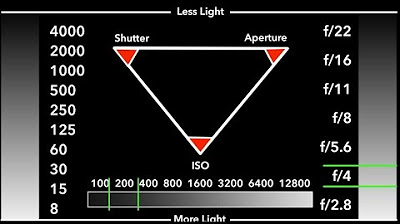Canon EOS | Getting Started: Light Meter Tutorial
Summary
TLDRThis tutorial delves into the exposure triangle—ISO, shutter speed, and aperture—crucial for achieving correct exposure and creative control in photography. It explains how a light meter suggests settings based on chosen ISO, and the need to balance aperture and shutter speed for desired effects. The video highlights the creative implications of these settings, such as depth of field and motion control, and encourages practice for better understanding.
Takeaways
- 📸 **Exposure Triangle**: The foundation of photography is the balance between ISO, shutter speed, and aperture, known as the exposure triangle.
- 🌡️ **ISO Sensitivity**: ISO determines the camera's sensitivity to light, affecting the amount of light needed for correct exposure.
- ⏱️ **Shutter Speed**: Shutter speed controls the duration the sensor is exposed to light, impacting motion capture.
- 🔍 **Aperture (F-stop)**: Aperture controls the size of the lens opening, affecting the amount of light entering and the depth of field.
- 🔄 **Variable Combinations**: The light meter suggests variable combinations of aperture and shutter speed to achieve the same exposure.
- 🔄 **Creative Compensation**: If one element of the exposure triangle is changed, the other must be adjusted to maintain the correct exposure.
- 📷 **Depth of Field**: A wide aperture creates a shallow depth of field, while a smaller aperture increases the depth of field, focusing more of the scene.
- 🏃 **Motion Control**: Faster shutter speeds can freeze motion, while slower speeds can create motion blur, adding artistic effects.
- 🎨 **Creative Prioritization**: Photographers prioritize aperture for depth of field or shutter speed for motion effects based on creative vision.
- 🚀 **ISO Adjustment**: Changing ISO can alter the range of aperture and shutter speed combinations available for achieving the desired effect.
- 💡 **Practice and Clarity**: Understanding the exposure triangle improves with practice, making photography techniques clearer over time.
Q & A
What is the exposure triangle in photography?
-The exposure triangle refers to the three elements of ISO, shutter speed, and aperture that come together to give the correct exposure and serve the photographer's vision in a photograph.
What does a light meter measure in photography?
-A light meter measures the amount of light needed to give the correct exposure based on the ISO or sensitivity that has been chosen.
What is meant by 'correct exposure' in photography?
-Correct exposure means the right amount of light reaching the sensor to allow for a faithful recreation of the scene in the photograph.
How is the relationship between aperture and shutter speed managed in photography?
-The relationship is managed by adjusting one to compensate for changes in the other. If one is changed, the other must be adjusted to maintain the same exposure.
What creative outcomes can different aperture and shutter speed combinations deliver?
-Different combinations can deliver varying depths of field and motion effects. A large aperture allows for a shallow depth of field, while a small aperture provides a greater depth of field. Fast shutter speeds can freeze motion, while slow shutter speeds can create motion blur.
Why is it important to consider the creative implications of shutter speed and aperture choices?
-It is important because these choices directly affect the visual outcome of the photograph, influencing the depth of field and the representation of motion.
How does the ISO setting affect the aperture and shutter speed combination?
-The ISO setting affects the sensitivity to light, and changing it can shift the range of aperture and shutter speed combinations available for achieving the desired exposure and creative effects.
What is the role of ISO in the exposure triangle?
-ISO determines the camera's sensitivity to light, and it works in conjunction with aperture and shutter speed to achieve the correct exposure.
How does the depth of field change with different aperture settings?
-A wide aperture (e.g., F4) results in a shallow depth of field with less in focus, while a smaller aperture (e.g., F16) gives a greater depth of field with more in focus.
What are the creative considerations when choosing between aperture and shutter speed as a priority?
-If depth of field is the most important creative element, aperture is chosen as a priority. If capturing motion or freezing movement is crucial, shutter speed is prioritized.
What advanced creative modes are available on an EOS camera?
-The advanced creative modes on an EOS camera allow the photographer to choose either aperture or shutter speed, and the camera will automatically adjust the other to achieve the correct exposure.
Outlines

This section is available to paid users only. Please upgrade to access this part.
Upgrade NowMindmap

This section is available to paid users only. Please upgrade to access this part.
Upgrade NowKeywords

This section is available to paid users only. Please upgrade to access this part.
Upgrade NowHighlights

This section is available to paid users only. Please upgrade to access this part.
Upgrade NowTranscripts

This section is available to paid users only. Please upgrade to access this part.
Upgrade NowBrowse More Related Video

Introduction to Exposure

Understanding Exposure: The Exposure Triangle with Mark Wallace

80% Of Photography Basics In Just 10 Minutes

APERTURE, SHUTTER SPEED AND ISO/ THE EXPOSURE TRIANGLE MADE EASY!

PAHAM SEGITIGA EXPOSURE DI FOTOGRAFI TERBARU 2023, TERLENGKAP!

What is ISO — Camera ISO and the Exposure Triangle Explained [Ep 2]
5.0 / 5 (0 votes)